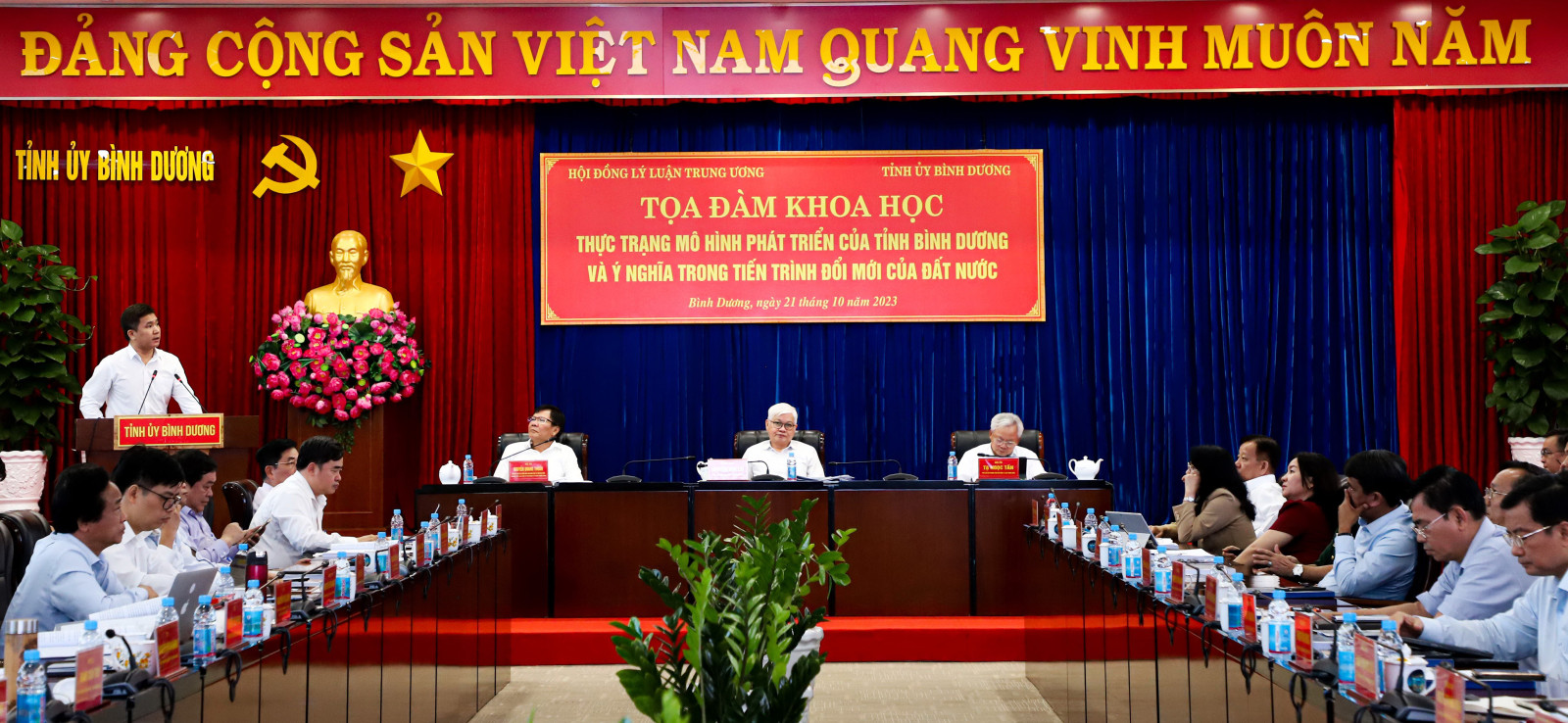The success story takes wing
Within the framework of the cooperation program between the Binh Duong provincial Party Committee and the Central Theory Council, implementing the project of "Summary of the development model of Binh Duong province in the process of national innovation and vision towards 2050", over the weekend, the two units coordinated to organize a scientific discussion about "The current status of the development model of Binh Duong province and the meaning in the country's innovation process."
To elaborate the 25 years' achievements
Speaking to introduce the discussion, Prof. Dr. Nguyen Quang Thuan, Head of the Economic Subcommittee of the Central Theory Council, emphasized that after nearly 40 years of innovation, along with the country's outstanding development, Binh Duong has become become a pioneer locality with the right choices and practices to become one of the most successful localities in Vietnam in terms of openness, investment attraction and economic development. Today, Binh Duong is an industrialized province with high average income. In 2022, Binh Duong was the locality with the highest per capita income in the country at VND 170 million (equivalent to over 7,000 US dollars). Not only did it excel in the field of economic development, Binh Duong also achieved important results in the fields of culture, society, human development, environmental protection, ensuring national defense and security, social order and safety, and building the Party and political system.

Prof. Dr. Ta Ngoc Tan, Standing Vice Chairman of the Central Theory Council, affirms that Binh Duong's development is a very special model in Vietnam. Photo: Quoc Chien
Binh Duong's success is rooted from its creative and unique approach that the "working together" between the government and businesses plays a key role. However, in the context of a rapidly changing and difficult to predict world, many new factors appear. Prof. Dr. Nguyen Quang Thuan emphasized that the discussion is a step to better perceive, appreciate and fully appreciate the development model of Binh Duong province as a typical model of local development at the provincial level in Vietnam during the innovation period, contributing to the task of summarizing the country's 40 years of innovation and building theory on the Party's innovation policy.
Previously, in the opening speech of the seminar, Prof. Dr. Ta Ngoc Tan, former member of the CPV Central Committee, Standing Vice Chairman of the Central Theory Council, wanted scientists to focus on exchanging and discussing , commenting, clarifying and deepening the characteristics, conditions and especially the causes leading to the success of Binh Duong where lessons can be drawn to serve the task of summarizing the development model not only for Binh Duong province but for the whole country.
Opportunities and challenges in spotlight
At this seminar, the Organizing Committee received 28 presentations. Prof. Dr. Ta Ngoc Tan said that the content of the reports was vivid to great scientific content. In addition, 7 presentations and 3 opinions were exchanged and discussed at the seminar. The content of the presentations and exchanged opinions were rich in theoretical and practical values.

This scientific seminar is a step to better understand and evaluate the development model of Binh Duong province. Photo: Quoc Chien
Many presentations approached the problem with both generality and depth of a practical summary and theoretical development, such as the presentation of "Resolving some major relationships in the process of socio-economic development in Binh Duong province" by Associate Professor, Dr. Nguyen Quoc Dung - Director of the National Academy of Politics Region 2, presentation of "General development model of Binh Duong province over 25 years: characteristics, current situation, problems, solutions and recommendations" presented by Dr. Huynh Ngoc Dang - Chairman of the provincial Historical Science Association, presentation of "How Binh Duong continues to write its economic success story after 25 years" by Prof. Dr. Tran Tho Dat - former President of Hanoi National University of Economics.
Many presentations and discussions at the seminar assessed that after more than 25 years of construction and development, Binh Duong has impressively achieved in all aspects. Outstanding features are rapid industrialization and economic restructuring towards industry, urbanization, and services with strong development of infrastructure, especially regional connection infrastructure works, the strengthening of the attraction of foreign direct investment (FDI) associated with the formation of industrial parks on the basis of promoting the leading role of state-owned enterprises and well resolving the relationship between the development of state-owned and private and FDI enterprises, effective solutions to social issues such as labor and employment, social security, poverty eradication and social housing issues, as well as ensuring political security issues, social order and safety so that businesses and people have stability and confidence in socio-economic development.
However, some opinions also believed that the past development model still has certain shortcomings and limitations. To continue to develop Binh Duong province in the spirit of the Resolution of the 13th CPV Congress and the 11th provincial Party Congress, Binh Duong needs to continue to steadfastly innovate its development model in the direction of attracting investors strategically, building production and product chains; at the same time, synchronously implement focuses and breakthroughs in institutions, infrastructure, human resources, science and technology and land to optimize the development process and resources of Binh Duong province.
Reported by Tri Dung – Translated by Vi Bao

